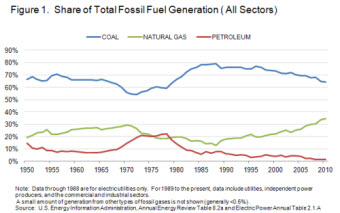Fuel Competition in Power Generation and Elasticities of Substitution
Release date: June 2012
This report analyzes the competition between coal, natural gas and petroleum used for electricity generation by estimating what is referred to by economists as the elasticity of substitution among the fuels. The elasticity of substitution concept measures how the use of these fuels varies as their relative prices change. It should be noted that many factors other than fuel prices play important roles in determining which power plants are run to meet electricity demand as it varies over time. These factors include generators' nonfuel variable operating costs, startup/shut down costs, emission rates and allowance costs, electricity grid flow constraints, and reliability constraints. Electricity system operators evaluate all of these factors when determining which plants and fuels to use.
The patterns of dispatching power generation have changed noticeably over the past few years. A number of factors, especially volatile fossil fuel costs, have altered the mix of energy sources used to produce electricity (Figure 1).
figure data
Coal has been the predominant fuel used in power generation over the last 60 years, and saw its share expand during the 1980s in response to higher oil prices following two price shocks during the 1970s.
By 1990, changes in the regulatory structure and legislation affecting the electricity industry started providing more opportunities for substitution between petroleum and natural gas as a fuel for peaking generation. During the 1990s and 2000s, the generation costs for plants fueled by natural gas fell dramatically as a result of lower natural gas fuel prices and the increased use of combined cycle technology for power generation. Natural gas production from domestic shale gas formations began to rapidly increase starting in 2005, which has led to a relatively sustained period of low natural gas prices. All of these factors have led to a continuing electric power industry trend of substituting coal-fired generation with natural gas-fired generation.
Earlier academic studies analyzed fossil fuel substitution during the period of the 1980s and 1990s. This report updates the earlier work to reflect dispatching patterns during the period of 2005-2010. The model results indicate that for the United States as a whole, a 10-percent increase in the ratio of the delivered fuel price of coal to the delivered price of natural gas leads to a 1.4-percent increase in the use of natural gas relative to coal. Generators' use of petroleum is much more responsive to relative fuel price changes. A 10-percent increase in the price ratio of natural gas to petroleum leads to a 19-percent increase in the relative use of petroleum compared with natural gas. The model results are the most robust for the southeastern United States, while fuel substitution results for the Midwest and Texas are relatively insignificant.
